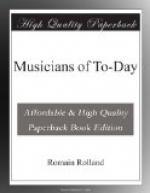[Footnote 97: Memoires, I, 17.]
[Footnote 98: Letter to an unknown person, written probably about 1855, in the collection of Siegfried Ochs, and published in the Geschichte der franzoesischen Musik of Alfred Bruneau, 1904. That letter contains a rather curious analytical catalogue of Berlioz’s works, drawn up by himself. He notes there his predilection for compositions of a “colossal nature,” such as the Requiem, the Symphonie funebre et triomphale, and the Te Deum, or those of “an immense style,” such as the Imperiale.]
It was the Symphonie funebre et triomphale for two orchestras and a choir, and the Te Deum for orchestra, organ, and three choirs, which Berlioz loved (whose finale Judex crederis seemed to him the most effective thing he had ever written[99]), as well as the Imperiale, for two orchestras and two choirs, and the famous Requiem, with its “four orchestras of brass instruments, placed round the main orchestra and the mass of voices, but separated and answering one another at a distance.” Like the Requiem, these compositions are often crude in style and of rather commonplace sentiment, but their grandeur is overwhelming. This is not due only to the hugeness of the means employed, but also to “the breadth of the style and to the formidable slowness of some of the progressions—whose final aim one cannot guess—which gives these compositions a strangely gigantic character."[100] Berlioz has left in these compositions striking examples of the beauty that may reveal itself in a crude mass of music. Like the towering Alps, they move one by their very immensity. A German critic says: “In these Cyclopean works the composer lets the elemental and brute forces of sound and pure rhythm have their fling."[101] It is scarcely music, it is the force of Nature herself. Berlioz himself calls his Requiem “a musical cataclysm."[102]
[Footnote 99: Memoires, II, 364. See also the letter quoted above.]
[Footnote 100: Memoires, II, 363. See also II, 163, and the description of the great festival of 1844, with its 1,022 performers.]
[Footnote 101: Hermann Kretzschmar, Fuehrer durch den Konzertsaal.]
[Footnote 102: Memoires, I, 312.]
These hurricanes are let loose in order to speak to the people, to stir and rouse the dull ocean of humanity. The Requiem is a Last Judgment, not meant, like that of the Sixtine Chapel (which Berlioz did not care for at all) for great aristocracies, but for a crowd, a surging, excited, and rather savage crowd. The Marche de Rakoczy is less an Hungarian march than the music for a revolutionary fight; it sounds the charge; and Berlioz tells us it might bear Virgil’s verses for a motto:—
" ... Furor iraque mentes
Praecipitant, pulchrumque
mori succurrit in armis."[103]




